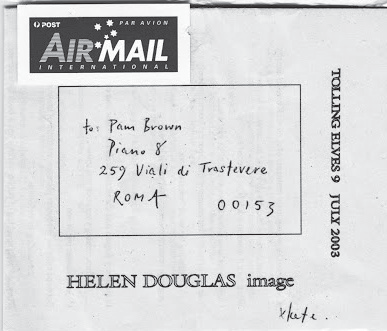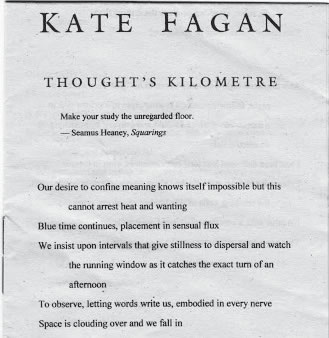
PAM BROWN
Launch of ‘First Light’ by Kate Fagan
Gleebooks, Glebe, Sydney 6th May 2012, (published by Giramondo)
It is terrific to have, at last, another set of poems by Kate
Fagan gathered into one collection. Kate’s first book, The Long
Moment, was published ten years ago now. In a blurb for that
book I wrote that Kate’s ‘meditative lyricism informs a knowing
philosophical scepticism’. I also said that the poems’ imagery
was like a gracefully imploding op-art screen saver and I think
that now I could say something similar about First Light,
except that now the lyricism is less meditative, the screen
saver imagery has become more insistent and the scepticism is
more evident. These qualities sit alongside details of the actual
world, and the developments in Kate’s life in the past decade.
The ‘threshold’ has been a trope in women’s poetry for
a long time now. Perhaps it’s a reflection or indication of
feminine mutability, of not wanting to be fixed or tied down -
or perhaps it’s an echo of the Pre-Raphaelites and the convent
threshold, a private yet structured location for women. Each
of these associations is possible. I think many of Kate’s poems
are on a threshold or a brink of a crossing, and they are kind
of consciously off-centre, as she threads and links lines of
thought and feeling.
They are imbued with a relational aesthetic - sometimes an
intimacy and ‘an interwoven private and public temporality’.1
Kate has hopes for her poems and songs as being ‘a true
reflection of where art actually comes from: messy worlds and
human connection.’2
Her poetry has obvious lyrical elements -
I will leave before summer
returns with its lilting cuckoos
and resonant air, before your taste
disappears from my tongue.
That’s from ‘The Correspondence’ - a sequence that is
literally letters-as-poems. ‘The Correspondence’ is also a
response to a musical composition by Luke Plumb. They’re a
component of a piece called ‘The Ten Titles Project’. Here Kate
contemplates the concept of truth. There is an elegiac tinge to
the entire collection but especially in ‘The Correspondence.’
In part, these are letters to herself and also love letters that
function as an anodyne to soothe a wound -
This is an elegy for a rift
that will never be mended
-
Truth is rebuilt every day
from this melancholy.
-
You will return on a day that does not exist.
I will call this ‘redemption’.
-
Carry my obsession past me
to the quick of feeling.
I think we can talk about modalities in Kate’s poetry,
especially given her parallel activities as a singer-songwriter
musician and her keen awareness of what she calls the
‘cadence of language’. She has said ‘Poetry is an art of thinking
in language. But it’s also a sonic art that sounds out the
relationships between words and things, writing and speech,
between our experiences and the way we hear them. I like the
idea of an unquiet poetry.’
This poem is sonic. It could be sung -
Out where sun-sweet grasses
push at eucalyptus stumps,
where piney hulks
restrain the sky and cockatoos
crack succour
from sappy cones
before rising in a whump
of jewelly wings, where jumping
jodies teem cyrillic
over littered bark
*
There are also formal attributes here. In one poem ‘The
Octet Rule’ the constraint is that each stanza is made of eight
lines. It begins by quoting John Cage - ‘The wind turns around,
no longer/facing in its direction’. And although the poem is
formal and conceptual it also, oddly, has l-a-n-g-u-a-g-e-y
traces, where the concern shows how relations of power that
inform the everyday are disseminated through language. Kate
writes, outright, ‘I find true authority unbearable’. So there are
hints of this influence in the poem. It starts with a glimpse of
reworked Walt Whitman -
Engines roar, body electric
leaves outside. Comedy
is a kind of basic displacement.
A & B are lost objects competing
for primacy. If asked for a shape
I’d say: define cylindrical.
The poem is not exhausted,
atmosphere new on location.
=
So what if machines parody
future empires. An instinct
for novels, last ride home
*
This collection has a variety of types of poems, something
for all comers. In a long philosophical poem ‘Observations on
Time, Cargo’ - ‘I decide upon four themes:/ tragedy, character,
temporality, locus’ - there’s a terrific encapsulation of laughter -
Laughing, the body falls through
a reversible current
And if you like punctuation, and I’m sure you do, you’ll like
the ‘flocks of apostrophes’ that ‘skirt the ‘bright obvious’ stillhouse
of speech.’
There’s also, following that ‘instinct for novels’ that I quoted
earlier, ‘A Book of Hours for Narrative Lovers’. That’s nice
ambiguity in ‘Narrative Lovers’, which is really not so much a
story as a gracefully written series of spacy, short prose pieces.
And there are several incidental, in situ kind of poems in
the section called ‘Authentic Nature’.
*
You’ll also find a reissue. The book collects the ephemeral
poem - ‘Thought’s Kilometre’, which arrived as if blown in on
the breeze off the Tiber when I was in the poet’s flat in Rome
nine years ago. It was published by the mysterious ‘Tolling
Elves’ -
Here it is - a little pamphlet thing.


And now that I’ve brought Rome into it, I’ll go back to
the beginning. The second part of the book, the title section,
comprises ten centos - inventive bundles of borrowed and
recombined poems, each one dedicated to or written for
friends and family. (That’s Kate’s ‘relational aesthetic’ again.)
Cento comes from Latin and used to mean a cloak made
of patches. Roman soldiers used these centones, or old
stuff patched over each other, maybe as repair or maybe as
camouflage. The cento poem originated in the 3rd or 4th
century. The first known centos were composed from works by
the Roman poet Virgil (Dante Alighieri’s mentor).
Here is an extract from one of Kate’s centos - it samples
W.G.Sebald - ‘Love of the Loveless’, Cento for Tom Lee -
Pretty much alone with
the eye unrecounted,
heart almost telescopic.
A glorious early summer’s day,
behind glass. At home with ever
greater frequency I hardly
I heard I lived I didn’t
I become. Old photographs
seem to have this, people walking
around you never always
empty
something
image
day
shine
*
Towards the end of the book Kate quietly introduces
optimism into her poems via the pioneering underground
experimental Soviet poet, Nina Iskrenko, who opened the way
in the 1980s for a ‘new generation’ of Russian poets.
Kate quotes her directly -
Nina Iskrenko wrote: the world tumbles and is caught
In consciousness a blazing future is predicted
*
In this blazing future my reading remix registers and savours
First Light’s quietly warped syntax - ‘must a sentence stop and
settle /I bend to drafts and read each tablet /a memory made
haphazard in a high storm’ - that is to say electrified by many
of the flashes of phrases in these poems.
I heard someone say recently that poetry doesn’t have a
readership but rather it has a thinkership. To welcome First
Light into the reading and thinking poetry world I have made
a short cento from Kate’s poems. It’s called ‘Blue or White’ -
the world was a little darker
before it was blue
brilliant as nowhere special to go
you could try double blinds
machines parody all future empires
say goodbye to the supermarket.
unbearable authority makes me dizzy
shocked by faultless mathematics
technicolour pesticides and diesel slops,
i turn away ekphrastic
into a new present
of geometry and truth, neo-conservative
precision, anachronisms make truth
a panacea for ego, and the gesture
troubles me, still asking
opposite questions -
talk less, mark slow time,
draw inconclusive ends, hope resting
with invention
Show us some of that hope and invention Kate ... over to you.
1 Rachel Blau DuPlessis, talk at Sydney University, 4th April, 2012.
2 Kate Fagan interviewed by Sarah Gory, Queensland Poetry Festival, 2011.